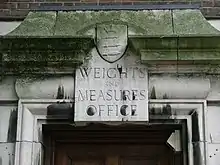وحدات إمبراطورية
وحدات إنجليزية أو نظام وحدات القياس الإمبراطورية أو النظام الإمبراطوري (والمعروف أيضًا باسم النظام البريطاني الإمبراطوري[1]) هو نظام وحدات القياس الذي تم تعريفه لأول مرة في قانون الأوزان والمقاييس البريطاني لعام 1824م، والذي تم تنقيحه واختزاله في وقت لاحق. وقد دخل هذا النظام حيز الاستخدام الرسمي عبر أنحاء الإمبراطورية البريطانية. تحولت رسميًا معظم البلدان التي كانت تتبع الإمبراطورية السابقة إلى استخدام النظام المتري كنظام أساسي للقياس وفي أواخر القرن العشرين الميلادي، (التحول إلى النظام المتري)، غير أن المملكة المتحدة بدأت في تطبيق هذا النظام جزئيًا فقط اعتبارًا من عام 2011م.

مكتب الأوزان والمقاييس السابق في سيفن سيسترز، لندن (Seven Sisters, London).
الطول
| الوحدة | بالنسبة إلى سابقة | قدم | مليمتر | متر | ملاحظات |
|---|---|---|---|---|---|
| thou (th) | 1/12000 | 0.0254 | 0.0000254 |
| |
| بوصة (in) | 1000 thou | 1/12 | 25.4 | 0.0254 | |
| قدم | 12 inches | 1 | 304.8 | 0.3048 | |
| يارد | 3 قدم | 3 | 914.4 | 0.9144 |
|
| سلسلة (ch) | 22 ياردة | 66 | 20,116.8 | 20.1168 |
|
| فرلنغ (fur) | 10 chains | 660 | 201.168 |
| |
| ميل | 8 furlongs | 5,280 | 1,609.344 |
| |
| league (lea) | 3 ميل | 15,840 | 4,828.032 |
| |
| الوحدات البحرية | |||||
| قامة | ~2 ياردة | 6 | 1,828.8 | 1.8288 |
|
| cable | 100 fathoms | 608 | 185.3184 |
| |
| ميل بحري | 10 cables | 6,080 | 1,853.184 |
| |
| Gunter's survey units (17th century onwards) | |||||
| link | 7.92 inches | 66/100 | 201.168 | 0.201168 |
|
| قصبة (وحدة قياس) | 25 links | 66/4 | 5,029.2 | 5.0292 |
|
| سلسلة | 4 rods | 66 | 20.1168 |
| |
المساحة
| الوحدة | بالنسبة لوحدات الطول | قدم مربع | قضبان مربعة | ميل مربع | متر مربع | هكتار | ملاحظات |
|---|---|---|---|---|---|---|---|
| قصبة | 1 rod × 1 rod | 272.25 | 1 | 1/102400 | 25.29285264 | 0.002529 |
|
| rood | 1 furlong × 1 rod[4] | 10,890 | 40 | 1/2560 | 1,011.7141056 | 0.1012 |
|
| أكر | 1 furlong × 1 chain | 43,560 | 160 | 1/640 | 4,046.8564224 | 0.4047 |
|
| Note: All equivalences are exact except hectares, which are accurate to 4 significant figures. | |||||||
انظر أيضًا
|
|

معايير قياس الطول الإمبراطورية عام 1876م في ميدان ترافالغار (Trafalgar Square)، لندن.
المراجع
- Britannica Educational Publishing (01 أغسطس 2010)، The Britannica Guide to Numbers and Measurement، The Rosen Publishing Group، ص. 241، ISBN 978-1-61530-218-5، مؤرشف من الأصل في 30 أبريل 2016، اطلع عليه بتاريخ 10 ديسمبر 2011.
- The exact figure was 6.08 feet, but 6 feet was in use in practice. The commonly accepted definition of a fathom was always 6 feet. The conflict was inconsequential as Admiralty nautical charts designated depths shallower than 5 fathoms in feet on older imperial charts. Today, all charts worldwide are metric, except for USA Hydrographic Office charts, which use feet for all depth ranges.
- The ميل بحري was not readily expressible in terms of any of the intermediate units, because it was derived from the circumference of the Earth (like the original metre).
- "Appendix C: General Tables of Units of Measurements" (PDF)، NIST، مؤرشف من الأصل (PDF) في 24 نوفمبر 2011، اطلع عليه بتاريخ 04 يناير 2007. [وصلة مكسورة]
- Appendices B and C of NIST Handbook 44
- Barry N. Taylor's NIST Special Publication 811, also available as a PDF file
وصلات خارجية
- British Weights And Measures Association
- Canada Weights and Measures Act 1970-71-72
- General table of units of measure – NIST – pdf
- How Many? A Dictionary of Units of Measurement
- Statutory Instrument 1995 No. 1804 Units of Measurement Regulations 1995
- بوابة الإمبراطورية البريطانية
- بوابة الفيزياء
- بوابة المملكة المتحدة
This article is issued from Wikipedia. The text is licensed under Creative Commons - Attribution - Sharealike. Additional terms may apply for the media files.